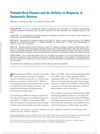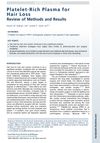TLDR Using your own blood (PRP) can effectively increase hair count and strength in men with hair loss.
The study involved 61 male patients aged 18-60 years with androgenetic alopecia, treated with autologous platelet-rich plasma (PRP) over 6 months. Results showed a significant increase in hair count, from 21.50±4.57 to 78.10±16.24 hairs per dermatoscopic field, and stronger hair, as indicated by negative hair pull tests post-treatment. The study concluded that PRP is an effective, cost-effective, and easy treatment for male androgenetic alopecia, despite limited published data. However, it acknowledged the need for further large-scale, multi-institutional research, and studies evaluating the effects of environmental and hygienic conditions on the treatment.
 65 citations
,
April 2020 in “International Journal of Molecular Sciences”
65 citations
,
April 2020 in “International Journal of Molecular Sciences” PRP injections may be a safe, effective alternative for hair loss treatment compared to minoxidil and finasteride.
 21 citations
,
June 2019 in “Dermatologic Surgery”
21 citations
,
June 2019 in “Dermatologic Surgery” Platelet-rich plasma (PRP) treatment has been found effective in promoting hair growth for alopecia patients, with minimal side effects like temporary pain and redness.
 4 citations
,
August 2018 in “Facial Plastic Surgery Clinics of North America”
4 citations
,
August 2018 in “Facial Plastic Surgery Clinics of North America” Platelet-Rich Plasma (PRP), a protein-rich extract from a patient's blood, shows promise in improving hair density, thickness, and quality, but the best method of use and number of treatments needed for noticeable results are still unclear.
 36 citations
,
August 2017 in “Journal of Cosmetic Dermatology”
36 citations
,
August 2017 in “Journal of Cosmetic Dermatology” PRP with microneedling effectively treats hair loss, and dermoscopy helps evaluate results.
 53 citations
,
June 2017 in “Skin appendage disorders”
53 citations
,
June 2017 in “Skin appendage disorders” PRP treatment helps hair growth in most cases, but more research needed.

Combining PRP and microneedling effectively improves hair growth and patient satisfaction for hair loss.






